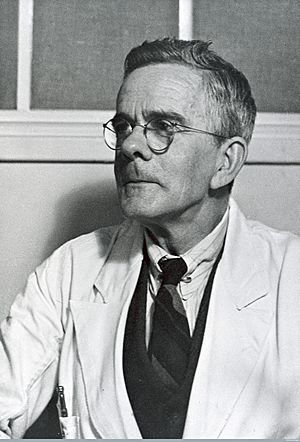Alexander Glenny facts for kids
Quick facts for kids
Alexander Thomas Glenny
|
|
|---|---|
 |
|
| Born | 18 September 1882 |
| Died | 5 October 1965 |
Alexander Thomas Glenny (born 18 September 1882 – died 5 October 1965) was a British scientist. He was an immunologist, which means he studied how our bodies fight off diseases. He is especially famous for his work on preventing a serious illness called diphtheria.
Contents
Who Was Alexander Glenny?
Alexander Glenny was a brilliant scientist who helped make vaccines better. His discoveries changed how we protect people from diseases. He focused on understanding how our bodies create defenses against germs.
Early Life and Education
Alexander Glenny was born in Camberwell, a part of London, England. This was on 18 September 1882. He went to Alleyn's School in Dulwich. Later, he earned a science degree (B.Sc.) from the University of London in 1905.
A Career in Science
In 1899, when he was just 17, Glenny started working. He joined the Wellcome Research Laboratories. These labs were in Central London. By 1906, he became the head of their immunology department. This meant he led the team studying how our bodies fight sickness.
Fighting Diseases with Science
Glenny worked on ways to protect people from diseases. He studied immunization and antitoxins. Antitoxins are special substances that fight poisons made by germs. His work helped create treatments for serious illnesses like tetanus and diphtheria. Later in his career, he even worked on defenses against chemical weapons.
Discovering How Immunity Works
A big part of Glenny's work was understanding how our bodies make antibodies. Antibodies are like tiny soldiers our body creates to fight off specific germs.
In 1921, he and another scientist, H. J. Südmersen, made a key discovery. They found out about the "primary" and "secondary" immune response. This means how your body first reacts to a germ, and then how it reacts much faster and stronger if it sees the same germ again.
In the same paper, they also talked about diphtheria toxoid. A toxoid is a weakened form of a germ's poison. It's used in vaccines to teach your body to fight the real poison. Glenny had actually discovered this toxoid by accident in 1904.
Later, in 1925-1926, he made the diphtheria toxoid even better. He developed something called "alum-precipitated diphtheria toxoid." This was a more effective way to make the diphtheria vaccine. It helped protect many more people.
Lasting Legacy
Alexander Glenny's important work was recognized by other scientists. In 1944, he was chosen to be a Fellow of the Royal Society. This is a very high honor for scientists in the UK. In 1953, he received the Edward Jenner Medal. This award is given for important work in immunology.
Glenny passed away in 1965. He had married Emma Blanche Lillian Gibbs in 1910. They had three children: John, Peter, and Barbara. His scientific contributions continue to help us understand and fight diseases today.

